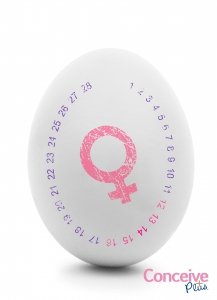
Understanding Your Ovulation Cycle and Falling Pregnant
If you’re ready to start trying to conceive, understanding your ovulation cycle can be key to falling pregnant. It’s a good idea to revisit some of your high school biology and learn the ins and outs of the menstrual cycle, ovulation and ultimately conceiving.
A female is born with just under half a million eggs already stored within her ovaries. During puberty, generally between the ages of ten and fourteen, a girl will start her periods. Every month, a ripened egg is released from the ovary. The egg travels along the fallopian tube to the uterus/womb. If the egg has become fertilized by a sperm within the fallopian tube, it will embed itself within the uterus lining, and thus pregnancy begins. If the egg does not become fertilized, it will be flushed out, together with the uterus lining, which is when you have your menstrual bleed. Your period marks the beginning of the next cycle.
Generally, this cycle lasts around 28 days, give or take a few days. The time frame in which you can actually fall pregnant, or your fertile window, lasts only five or six days.
This is the time leading up to and including ovulation, where the egg is released and travels along the fallopian tube. The lifespan of the egg after ovulation is only 12–24 hours, so it has to be fertilized within this time frame, and the lifespan of the sperm is five days. It is these lifecycles that determine the fertile window period of six days. The day of ovulation, and the two days preceding it, offer the best chances of falling pregnant. But how do you know when you are going to ovulate, and therefore plan to fall pregnant? Ovulation generally occurs between 12 and 16 days before your next period starts. You must really get to know your body and learn your cycle, as you will need to have intercourse within with fertile window, preferably at the time of ovulation. Begin by working out what the length of your cycle is—day one of the cycle begins on the first day of your menstrual bleed, and the last day is the day before your next period starts. If you average a cycle of 28 days, you can guesstimate that you will ovulate around day 14 of the cycle. Utilize our ovulation calculator to keep track of your cycle and work out when your fertile window is likely to be.
Obviously every woman is different, and also a woman’s cycle may vary sometimes. This can make it quite difficult to determine when the fertile window is each month. Again, learning and reading the signs from your body can help. Below is a list of signs to look out for each month:
- Cervical mucus: a change in cervical mucus can indicate when you are fertile. When it becomes clear and stretchy yet slippery, similar to raw egg white, it’s a sign that you are close to ovulation.
- Some women can experience ovulatory pain, indicating that the process is occurring. It can be one-sided backache or a tender abdomen.
- After you have ovulated, your temperature rises slightly. You can track your basal body temperature daily over a few months to determine if there is a pattern. You can then pinpoint when you are going to ovulate and plan for intercourse in the days preceding this.
Pregnancy tips to help you conceive
The time to start working toward a healthy pregnancy is before you conceive. If you are trying to get pregnant quick, our pregnancy tips are good start to get your body ready for conception process.Information about Conceive Plus
If you have just started trying to get pregnant or have been trying for a while, Conceive Plus® can help increase your chances of conception naturally! Recommended by doctors, pharmacists and fertility clinics in more than 60 countries, this is the fertility friendly lubricant approved by the FDA and a prescription is not required.
For where to buy Conceive Plus, visit our where to buy page
